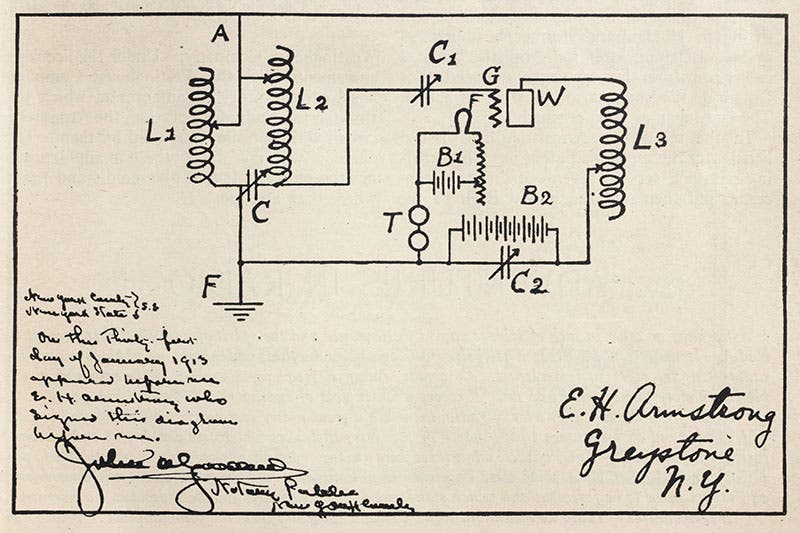Scientist of the Day - Edwin Armstrong
Edwin Armstrong, an American electrical engineer, was born in New York City on Dec. 18, 1890. As a child, Armstrong suffered from rheumatic fever, and his family moved to the nearby suburb of Yonkers to expedite his recovery. It was there that young Edwin became fascinated with science and technology, especially the newly emergent field of wireless communications. Inspired by Guglielmo Marconi’s recent success transmitting signals across the Atlantic Ocean, he started building his own radio equipment and eventually decided to study electrical engineering at Columbia University.
As a student at Columbia, Armstrong decided to investigate the audion, a device capable of amplifying electrical signals that had been developed in 1906 by wireless entrepreneur Lee de Forest. The audion was an evacuated glass tube containing three electrodes: a filament, a metal plate, and a wire mesh (or “grid”) that was positioned between them. Heating the filament caused it to emit electrons, which flew toward the positively charged plate. By applying a small voltage to the grid, it was possible to modulate the much larger flow of current across the tube.
In September 1912, Armstrong demonstrated that it was possible to increase the audion’s amplifying abilities by redirecting some of the current that arrived at the tube’s plate back into its grid, essentially creating a feedback loop. Not only did this “regenerative circuit” enable Armstrong to detect extremely faint radio transmissions but increasing the feedback levels even further caused the audion to generate high-frequency signals of its own. Although he recognized the significance of these findings, Armstrong did not submit a patent application for the regenerative circuit until October 1913. That delay would later haunt him during an extended legal battle with De Forest, who claimed to have anticipated Armstrong’s invention in a lab notebook entry from earlier that year.

Armstrong’s original drawing of the regenerative circuit published in the May 1922 issue of Radio Broadcast. (Linda Hall Library)
Following America’s entry into World War I, Armstrong traveled to Paris as an officer in the U.S. Army Signal Corps. While there, he developed the superheterodyne receiver, which converted high-frequency signals to a lower frequency better suited for amplification with existing vacuum tubes. Armstrong’s invention represented a significant improvement in both the sensitivity and selectivity of radio receivers. After the war, Armstrong licensed his invention to the newly established Radio Corporation of America (RCA), which proceeded to incorporate it into their Radiola product line. Today nearly all radio receivers can trace their design back to Armstrong’s superheterodyne system.

RCA Radiola advertisement published in the June 1924 issue of Radio (Linda Hall Library)
Armstrong had a long and often tumultuous relationship with RCA. Early on, the company was willing to make him their largest private shareholder in exchange for the rights to his inventions. He was also on friendly terms with the company’s vice president, David Sarnoff, who shared his passion for the technical side of radio broadcasting. (Armstrong would later marry Sarnoff’s secretary, Marion MacInnis.) But beginning in the 1930s, Armstrong’s goals began to diverge from RCA’s. Sarnoff, who had become the corporation’s president, became increasingly focused on the development of television. Meanwhile, Armstrong remained committed to his radio research.
In 1933, Armstrong invited Sarnoff to his laboratory at Columbia for a demonstration of an invention that he promised would finally eliminate static from the radio airwaves. Unlike previous radio systems, which transmitted information by adjusting the signal strength (or amplitude) of a radio wave—a technique known as amplitude modulation (AM)—Armstrong proposed a system that achieved the same outcome by varying the wave’s frequency. This frequency modulation (FM) approach offered excellent sound quality, but Sarnoff was reluctant to divert resources away from television to perfect Armstrong’s latest innovation.
Stung by Sarnoff’s rejection, Armstrong decided to develop the FM system on his own. He poured his savings into the construction of a 400-foot (122 m) tall transmission tower in Alpine, New Jersey, and cashed in his RCA stock to purchase broadcasting equipment.

Edwin Armstrong’s radio tower in Alpine, New Jersey (Photo by author)
By 1940, Armstrong had persuaded several radio stations throughout the northeastern United States to embrace FM. Unfortunately, these successes led him into direct conflict with David Sarnoff and RCA, which viewed FM as a threat to its existing AM radio business. In addition, Armstrong’s broadcasts made use of valuable bandwidth that RCA wished to keep available for television. After World War II, RCA successfully lobbied the Federal Communications Commission to reallocate the spectrum available for FM broadcasting, making thousands of FM sets obsolete.
FM broadcasting would eventually recover from this decision, and Armstrong mustered the strength to launch one final counterattack against RCA. In 1948, he filed a lawsuit against the company, claiming that it had infringed upon several of his FM patents. The resulting trial turned into an extended battle of attrition that put a significant strain on Armstrong’s finances and mental health. In January 1954, after more than five years of litigation, a despondent Armstrong committed suicide by jumping out of the window of his 13th floor apartment in Manhattan.
Edwin Armstrong’s story had a tragic ending, but he left behind a remarkable technological legacy. Anyone who has tuned into a radio broadcast—either AM or FM—has benefitted directly from his inventions.
Benjamin Gross, Vice President for Research and Scholarship, Linda Hall Library. Comments or corrections are welcome; please direct to grossb@lindahall.org.






